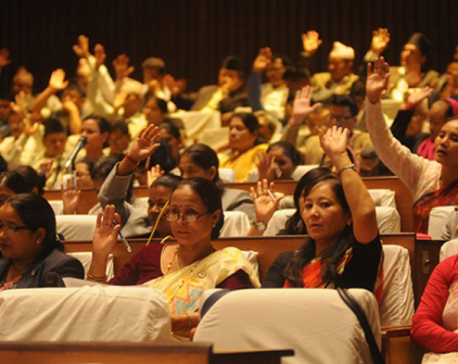
OR
health corner
Dr Rupak B Ghimire starts by saying he doesn’t associate a healthy scalp with a healthy person so “You can be and live for a hundred years and win a Nobel Prize,” he says. Many people, men in particular, have often had to suffer from low self-esteem and confidence issues due to their baldness. But Dr Ghimire’s Aavaran Skin and Hair Clinic has proven to be a solace of sorts.
 Aavaran’s clientele list includes average Joes from across age groups as well as celebrities. And they all can be spotted recommending the treatment in the clinic’s brochures as well as their website. So The Week caught up with the doctor to discuss all that one needs to know about hair transplant.
Aavaran’s clientele list includes average Joes from across age groups as well as celebrities. And they all can be spotted recommending the treatment in the clinic’s brochures as well as their website. So The Week caught up with the doctor to discuss all that one needs to know about hair transplant.
To begin with, is hair transplant surgery permanent?
Many may not know but we note the balding phenomenon in grades. It begins with Grade 1 where you are losing hair on the top and as the hairline recedes more, the grading increases. However, the balding pattern ends at Grade 7. This is because the hair on the lower back of the head of a healthy person is permanent.
Now in hair transplant surgery, we extract hairs from this very back and sides of the scalp known as the donor region and transplant amongst hairs on top that are prone to hair loss. Now this should answer your question. Since the transplanted hair is obtained from the part that is more genetically durable, it is considered permanent. Over the years, there may be changes in its density but the hair will remain.
Is the procedure popular among women as well?
Comparatively, there are more male patients but we do have female patients as well. I am actually going to Korea for a workshop on long hair transplant. Women also come for eyebrow transplant.
What is the hair transplant process like for patients?
When patients come in for the average number of 3000 grafts, we take about three hours for 1000-1500 grafts. That’s the required standard time. The procedure is carried out under local anesthesia. The patient is awake and very comfortable. We can arrange for coffee and bathroom breaks in between. If they want they can even watch a movie on an iPad because, in total, the procedure will take around eight to ten hours. Putting in the grafts takes another three or so hours.
What about post care, what do the patients have to be wary of? Also, are there any common symptoms?
Once the patients return home, we ask them to come back to the clinic after 48 hours. That’s when we remove the bandage and shampoo the front of the head where we had done the procedure.
Where the side effects are concerned, on the second or third day, some might witness some swelling on their foreheads. This isn’t anything to worry about. It isn’t caused because of damage to tissue or anything. The swelling is usually because of anesthesia. Since it can’t all be absorbed in a day, it spreads across through the forehead. If a patient continuously uses their cell phone or does a lot of table work with their head down, we have seen more swelling. Whereas sometimes, those who tend to lie down more in the following days don’t have such problems. Either way, we can deal with the problem with some basic penicillin.
When do the results start to appear?
We call our patients back on the seventh day. It is then that we remove the scabs that tend to form. But even then, you can see short bristles of hair on the transplanted area. But the next one to two months sees 80-90% of hair fall but this is completely normal. The patient will see re-growth following the hair fall. In the next four to five months, the hair on the transplanted area will start to match the density of the hair on its sides. It will take at least a year for it to reach maximum density though. After that, you can color the hair, iron them or even shave it all again, they will continue to grow back. This is the result you can expect from a successful hair transplant.
Do the results vary from individual to individual?
Yes, I’m afraid that is the case. The results do vary as it depends on the quality of the patient’s grafts. Some have healthy grafts ranging up to four in one extraction whereas there are also cases where you can only manage to get a single graft from patients (the average is two). So due to this, transplants on some people might look thin. You might notice that they have more space between their hair strands.
Are there any circumstances where a patient isn’t eligible for hair transplant at all?
Personally, I believe a good doctor is not known by the surgery he does, but rather by when he knows not to do a surgery. This applies to hair transplant as well. There have been patients who come in with relatively better hair density but still wanting a hair transplant. I often tell them that their answer lies in other forms of therapies. They could be taking medication, applying ointments or seeking PRP therapy where they take your plasma and inject it in your scalp, thus encouraging growth in the area. So yes, hair transplant isn’t the universal answer for hair loss.
Also, there tend to be patients who have less hair even on the back of their head (the donor area). I don’t think it’s best to force a transplant in these cases and I tell them so. We need to be realistic with our patients. I suggest that they could perhaps try tattooing hair. There are many other avenues of help for baldness and as doctors we need to help them find the treatment that matches their requirement the best.
What do you think about people’s awareness level on hair transplant procedures?
You do come across those who ask you whether hair transplant can cause cancer or affect your brain in any way. The answer to both is: No.
But I think patients ought to be careful about where they choose to carry out their hair transplants. I have had to redo many procedures in my time. And it doesn’t matter whether you travelled to Delhi or Turkey to get it done. There have been unsuccessful hair transplants from clinics abroad as well. It seems many are attracted by the discounts but I urge people to give more priority to their doctor’s ability.
The American hair loss society actually shares guidelines on how to find good doctors. They have given a list of questions that you should ask and proofs that you should collect before entrusting a doctor to carry out your hair transplant. I highly recommend those interested to go through the guidelines because there have been cases where clinics have been showing fake photos, those taken from the internet, on their portfolios. You need to be very careful about these things.
You May Like This

Right hair brush for various hair types
Do you know that one of the key reasons for hair fall and breakage is your hairbrush? No matter how... Read More...

Hair care tips for rainy season
With the onset of monsoon season, frizzy hair, hair fall and hair damage become everyday problems. Monsoon is known to... Read More...

The five basics
Reforms proposed in Draft Bills should be tabled in parliament in their original form and should on no account be... Read More...
Just In
- CPN (Unified Socialist) to hold its Central Committee meeting on May 10-11
- Over 16,000 paragliding flights conducted in one year in Pokhara
- MoPIT prepares draft of National Road Safety Act, proposes rescue within an hour of an accident
- Light rainfall likely in hilly areas of Koshi, Bagmati, Gandaki and Karnali provinces
- Customs revenue collection surpasses target at Tatopani border, Falls behind at Rasuwagadhi border in Q3
- Rain shocks: On the monsoon in 2024
- Govt receives 1,658 proposals for startup loans; Minimum of 50 points required for eligibility
- Unified Socialist leader Sodari appointed Sudurpaschim CM



















Leave A Comment